Application of Internet of Things (IoT) in Sustainable Supply Chain Management
Abstract
1. Introduction
2. Features of Smart Supply Chain Management
2.1. Intelligent
2.2. Interconnected
2.3. Instrumented
3. IoT Technologies
3.1. Wireless Sensor Networks (WSN)
3.2. RFID
3.3. Middleware
3.4. Computing Platform
4. IoT-Based Supply Chain Management System
4.1. IoT-Enabled Manufacturers
4.2. IoT-Enabled Distributors and Retailing
4.2.1. Smart Transportation
4.2.2. Smart Warehousing
4.2.3. Smart Loading and Unloading
4.2.4. Smart Carriage
4.2.5. Smart Packaging
4.2.6. Smart Distribution Processing
4.2.7. Smart Distribution
5. IoT-Based Retail Industry
6. Challenges of IoT in the Supply Chain
7. Conclusions
Author Contributions
Funding
Institutional Review Board Statement
Informed Consent Statement
Data Availability Statement
Acknowledgments
Conflicts of Interest
References
- Lu, L.; Navas, J. Advertising and quality improving strategies in a supply chain when facing potential crises. Eur. J. Oper. Res. 2020, 288, 839–851. [Google Scholar] [CrossRef]
- Ye, Y.; Lau, K.H.; Teo, L. Transforming supply chains for a new competitive market alignment—A case study of Chinese fashion apparel companies. Int. J. Logist. Res. Appl. 2021, 12, 1–33. [Google Scholar] [CrossRef]
- Reece, E.M.; Davis, M.J.; Abu-Ghname, A.; Castanon, J.M.; Voris, M.; Hoxworth, R.; Winocour, S.; Buchanan, E.P. Working Smarter, Not Harder: Using Data-Driven Strategies to Generate Front-End Cost Savings through Price Negotiation and Supply Chain Optimization. Plast. Reconstr. Surg. 2022, 149, 1488–1497. [Google Scholar] [CrossRef] [PubMed]
- Aljabhan, B. A Comprehensive Analysis on the Adoption of IoT with Logistics and Supply Chain Management. In Proceedings of the 2022 Second International Conference on Computer Science, Engineering and Applications (ICCSEA), Gunupur, India, 8 September 2022; IEEE: New York, NY, USA, 2022; pp. 1–6. [Google Scholar]
- Wu, H.; Shen, Y.; Tömösközi, M.; Nguyen, G.T.; Fitzek, F.H.P. Demonstration of In-Network Au-dio Processing for Low-Latency Anomaly Detection in Smart Factories. In Proceedings of the 2022 IEEE 19th Annual Consumer Communica-tions & Networking Conference (CCNC), Las Vegas, NV, USA, 8–11 January 2022; IEEE: New York, NY, USA, 2022; pp. 933–934. [Google Scholar]
- Belhadi, A.; Kamble, S.; Jabbour, C.J.C.; Gunasekaran, A.; Ndubisi, N.O.; Venkatesh, M. Manufacturing and service supply chain resilience to the COVID-19 outbreak: Lessons learned from the automobile and airline industries. Technol. Forecast. Soc. Chang. 2020, 163, 120447. [Google Scholar] [CrossRef]
- Burgos, D.; Ivanov, D. Food retail supply chain resilience and the COVID-19 pandemic: A digital twin-based impact analysis and improvement directions. Transp. Res. Part E Logist. Transp. Rev. 2021, 152, 102412. [Google Scholar] [CrossRef]
- De Vass, T.; Shee, H.; Miah, S.J. The effect of “Internet of Things” on supply chain integration and performance: An organisational capability perspective. Australas. J. Inf. Syst. 2018, 22, 3–7. [Google Scholar] [CrossRef]
- Haq, S.U.; Singh, Y. On IoT security models: Traditional and block chain. Int. J. Comput. Sci. Eng. 2018, 6, 26–31. [Google Scholar]
- Abdel-Basset, M.; Nabeeh, N.A.; El-Ghareeb, H.A.; Aboelfetouh, A. Utilising neutrosophic theory to solve transition difficulties of IoT-based enterprises. Enterp. Inf. Syst. 2020, 14, 1304–1324. [Google Scholar] [CrossRef]
- Ghorpade, S.; Zennaro, M.; Chaudhari, B. Survey of localization for internet of things nodes: Approaches, challenges and open issues. Future Internet 2021, 13, 210. [Google Scholar] [CrossRef]
- Ben-Daya, M.; Hassini, E.; Bahroun, Z. Internet of Things and supply chain management: A literature review. Int. J. Prod. Res. 2019, 57, 4719–4742. [Google Scholar] [CrossRef]
- Nozari, H.; Nahr, J.G. The Impact of Blockchain Technology and The Internet of Things on the Agile and Sustainable Supply Chain. Int. J. Innov. Eng. 2022, 2, 33–41. [Google Scholar]
- Sun, Z.-H.; Chen, Z.; Cao, S.; Ming, X. Potential Requirements and Opportunities of Blockchain-Based Industrial IoT in Supply Chain: A Survey. IEEE Trans. Comput. Soc. Syst. 2021, 9, 1469–1483. [Google Scholar] [CrossRef]
- Xia, L.; Liu, S. Intelligent IoT-based cross-border e-commerce supply chain performance optimization. Wirel. Commun. Mob. Comput. 2021, 2021, 9961925. [Google Scholar] [CrossRef]
- Nozari, H.; Fallah, M.; Szmelter-Jarosz, A. A conceptual framework of green smart IoT-based supply chain management. Int. J. Res. Ind. Eng. 2021, 10, 22–34. [Google Scholar]
- Wei, X.; Guo, H.; Wang, X.; Wang, X.; Qiu, M. Reliable Data Collection Techniques in Underwater Wireless Sensor Networks: A Survey. IEEE Commun. Surv. Tutor. 2021, 24, 404–431. [Google Scholar] [CrossRef]
- Singh, A.; Sharma, S.; Singh, J. Nature-inspired algorithms for Wireless Sensor Networks: A comprehensive survey. Comput. Sci. Rev. 2020, 39, 100342. [Google Scholar] [CrossRef]
- Evans, V.; Horak, J. Sustainable urban governance networks, data-driven internet of things systems, and wireless sensor-based applications in smart city logistics. Geopolit. Hist. Int. Relat. 2021, 13, 65–78. [Google Scholar]
- Xiao, X.; He, Q.; Fu, Z.; Xu, M.; Zhang, X. Applying CS and WSN methods for improving efficiency of frozen and chilled aquatic products monitoring system in cold chain logistics. Food Control 2015, 60, 656–666. [Google Scholar] [CrossRef]
- Chen, X. E-Commerce Logistics Inspection System Based on Artificial Intelligence Technology in the Context of Big Data. Secur. Commun. Netw. 2022, 2022, 3418466. [Google Scholar] [CrossRef]
- Asemani, M.; Abdollahei, F.; Jabbari, F. Understanding IoT platforms: Towards a comprehensive defi-nition and main characteristic description. In Proceedings of the 2019 5th International Conference on Web Research (ICWR), Tehran, Iran, 24–25 April 2019; IEEE: New York, NY, USA, 2019; pp. 172–177. [Google Scholar]
- Agarwal, P.; Alam, M. Investigating IoT Middleware Platforms for Smart Application Development. In Smart Cities—Opportunities and Challenges; Springer: Singapore, 2020; pp. 231–244. [Google Scholar]
- Kałaska, R.; Czarnul, P. Investigation of Performance and Configuration of a Selected IoT System—Middleware Deployment Benchmarking and Recommendations. Appl. Sci. 2022, 12, 5212. [Google Scholar] [CrossRef]
- Mohammadi, M.; Al-Fuqaha, A.; Sorour, S.; Guizani, M. Deep Learning for IoT Big Data and Streaming Analytics: A Survey. IEEE Commun. Surv. Tutor. 2018, 20, 2923–2960. [Google Scholar] [CrossRef]
- Shafiq, D.A.; Jhanjhi, N.Z.; Abdullah, A. Load balancing techniques in cloud computing environment: A review. J. King Saud Univ. Comput. Inf. Sci. 2021, 34, 3910–3933. [Google Scholar] [CrossRef]
- Dhirani, L.L.; Armstrong, E.; Newe, T. Industrial IoT, Cyber Threats, and Standards Landscape: Evaluation and Roadmap. Sensors 2021, 21, 3901. [Google Scholar] [CrossRef] [PubMed]
- Schmidt, M.C.; Veile, J.W.; Müller, J.M.; Voigt, K.I. Industry 4.0 implementation in the supply chain: A review on the evolution of buyer-supplier relationships. Int. J. Prod. Res. 2022, 16, 1–8. [Google Scholar] [CrossRef]
- Lu, Y. Industry 4.0: A survey on technologies, applications and open research issues. J. Ind. Inf. Integr. 2017, 6, 1–10. [Google Scholar] [CrossRef]
- Bibby, L.; Dehe, B. Defining and assessing industry 4.0 maturity levels–case of the defence sector. Prod. Plan. Control 2018, 29, 1030–1043. [Google Scholar] [CrossRef]
- Christian, L.; Martin, S.; Schäffer, T. Industry 4.0 and Lean Production—A matching relationship? An analysis of selected Industry 4.0 models. In Proceedings of the 2017 Federated Conference on Computer Science and Information Systems (FedCSIS), Prague, Czech Republic, 3–6 September 2017; IEEE: New York, NY, USA, 2017; pp. 989–993. [Google Scholar]
- Kamar, Z.; Cherrafi, A.; Bouhaddou, I.; Benabdellah, A.C.; Raut, R. A holonic architecture for the supply chain performance in industry 4.0 context. Int. J. Logist. Res. Appl. 2021, 12, 1–28. [Google Scholar] [CrossRef]
- Mohammed, K.; Santha, K. Design and Implementation of Vehicle Tracking System using GPS/GSM/GPRS Technology and Smartphone Application. Int. J. Sci. Eng. Technol. Res. 2015, 4, 35. [Google Scholar]
- Mondal, M.; Rehena, Z. An IoT-based congestion control framework for intelligent traffic management system. In Advances in Artificial Intelligence and Data Engineering; Springer: Singapore, 2021; pp. 1287–1297. [Google Scholar]
- Yan, Y. Research on the Innovation Path of Logistics Formats Based on 5G Technology. Open J. Bus. Manag. 2019, 7, 1936–1942. [Google Scholar] [CrossRef][Green Version]
- Liu, W.; Aiyun, Z.; Hongwei, L.; Menglin, Q.; Ruoqi, W. Dangerous goods dynamic monitoring and con-trolling system based on IOT and RFID. In Proceedings of the 2012 24th Chinese Control and Decision Conference (CCDC), Taiyuan, China, May 23–25 2021; IEEE: New York, NY, USA, 2012; pp. 4171–4175. [Google Scholar]
- Baygin, M.; Yaman, O.; Baygin, N.; Karakose, M. A blockchain-based approach to smart cargo transportation using UHF RFID. Expert Syst. Appl. 2021, 188, 116030. [Google Scholar] [CrossRef]
- Choudhari, S.D.; Giripunje, V.G. Remote healthcare monitoring system for driver’s community based on IoT. Int. J. Emerg. Technol. Eng. Res. 2016, 4, 117–121. [Google Scholar]
- Ma, X. Three-dimensional warehouse automated logistics control system based on ZigBee wireless network. J. Harbin Univ. Sci. Technol. 2016, 21, 67–72. [Google Scholar]
- Rameel, K.; Bhujbal, A.; Goudar, M. IoT enabled automated robotic service for warehouses. Int. J. Eng. Technol. Sci. Res. 2017, 4, 588–592. [Google Scholar]
- Liawatimena, S.; Felix, B.T.; Nugraha, A.; Evans, R. A mini forklift robot. In Proceedings of the The 2nd International Conference on Next Generation Information Technology, Gyeongju, Republic of Korea, 21–23 June 2011; IEEE: New York, NY, USA, 2011; pp. 127–131. [Google Scholar]
- Lu, S.; Xu, C.; Zhong, R.Y.; Wang, L. A RFID-enabled positioning system in automated guided vehicle for smart factories. J. Manuf. Syst. 2017, 44, 179–190. [Google Scholar] [CrossRef]
- Alluhaidan, A.S.; Alluhaidan, M.S.; Basheer, S. Internet of Things Based Intelligent Transportation of Food Products During COVID. Wirel. Pers. Commun. 2021, 34, 27. [Google Scholar] [CrossRef]
- Li TH, S.; Liu, C.Y.; Kuo, P.H.; Fang, N.C.; Li, C.H.; Cheng, C.W.; Hsieh, C.; Wu, L.; Liang, J.; Chen, C. A three-dimensional adaptive PSO-based packing algorithm for an IoT-based automated e-fulfillment packaging system. IEEE Access 2017, 5, 9188–9205. [Google Scholar]
- Xi, Z.; Shan, X.; Wei, J. Hybrid flexible smart temperature tag with NFC technology for smart packaging. In Proceedings of the 2017 IEEE 19th Electronics Packaging Technology Conference (EPTC), Singapore, 6–9 December 2017; IEEE: New York, NY, USA, 2017; pp. 1–5. [Google Scholar]
- Subramani, N.; Mohan, P.; Alotaibi, Y.; Alghamdi, S.; Khalaf, O.I. An Efficient Metaheuristic-Based Clustering with Routing Protocol for Underwater Wireless Sensor Networks. Sensors 2022, 22, 415. [Google Scholar] [CrossRef]
- Famá, F.; Faria, J.N.; Portugal, D. An IoT-based interoperable architecture for wireless biomonitoring of patients with sensor patches. Internet Things 2022, 19, 100547. [Google Scholar] [CrossRef]
- Song, Y.; Yu, F.R.; Zhou, L.; Yang, X.; He, Z. Applications of the Internet of Things (IoT) in Smart Logistics: A Comprehensive Survey. IEEE Internet Things J. 2021, 8, 4250–4274. [Google Scholar] [CrossRef]
- Asghar, U.; Lütjen, M.; Rohde An Lembke, J.; Freitag, M. Wireless pick-by-light: Usability of LPWAN to achieve a flexible warehouse logistics infrastructure. In Proceedings of the International Conference on Dynamics in Logistics, Bremen, Germany, 20–22 February 2018; Springer: Cham, Switzerland, 2018; pp. 273–283. [Google Scholar]
- Nagarajan, S.M.; Deverajan, G.G.; Chatterjee, P.; Alnumay, W.; Muthukumaran, V. Integration of IoT based routing process for food supply chain management in sustainable smart cities. Sustain. Cities Soc. 2021, 76, 103448. [Google Scholar] [CrossRef]
- Tsang, Y.P.; Choy, K.L.; Wu, C.H.; Ho GT, S.; Lam, H.Y.; Tang, V. An intelligent model for assuring food quality in managing a multi-temperature food distribution center. Food Control 2018, 90, 81–97. [Google Scholar] [CrossRef]
- Wang, F.; Wang, F.; Ma, X.; Liu, J. Demystifying the Crowd Intelligence in Last Mile Parcel Delivery for Smart Cities. IEEE Netw. 2019, 33, 23–29. [Google Scholar] [CrossRef]
- Mihai, A.; Lăzăroiu, G.; Iatagan, M.; Uță, C.; Ștefănescu, R.; Cocoșatu, M. Artificial Intelligence-Based Decision-Making Algorithms, Internet of Things Sensing Networks, and Deep Learning-Assisted Smart Process Management in Cyber-Physical Production Systems. Electronics 2021, 10, 2497. [Google Scholar]
- Hänninen, M.; Kwan, S.K.; Mitronen, L. From the store to omnichannel retail: Looking back over three decades of research. Int. Rev. Retail. Distrib. Consum. Res. 2020, 31, 1–35. [Google Scholar] [CrossRef]
- Verhoef, P.C. Omni-channel retailing: Some reflections. J. Strat. Mark. 2021, 29, 608–616. [Google Scholar] [CrossRef]
- Malik, R. Retail and Internet of Things: A Digital Transformation. In Advancing Smarter and More Secure Industrial Applications Using AI, IoT, and Blockchain Technology; IGI Global: Hershey, PA, USA, 2022; pp. 251–260. [Google Scholar]
- Pei, H.; Huang, X.; Ding, M. Image visualization: Dynamic and static images generate users’ visual cognitive experience using eye-tracking technology. Displays 2022, 73, 102175. [Google Scholar] [CrossRef]
- Aamer, A.M.; Al-Awlaqi, M.A.; Affia, I.; Arumsari, S.; Mandahawi, N. The internet of things in the food supply chain: Adoption challenges. Benchmarking Int. J. 2021, 28, 2521–2541. [Google Scholar] [CrossRef]
- Ahmed, S.; Kalsoom, T.; Ramzan, N.; Pervez, Z.; Azmat, M.; Zeb, B.; Rehman, M.U. Towards Supply Chain Visibility Using Internet of Things: A Dyadic Analysis Review. Sensors 2021, 21, 4158. [Google Scholar] [CrossRef]
- Yang, K.; Duan, T.; Feng, J.; Mishra, A.R. Internet of things challenges of sustainable supply chain management in the manufacturing sector using an integrated q-Rung Orthopair Fuzzy-CRITIC-VIKOR method. J. Enterp. Inf. Manag. 2021, 35, 1011–1039. [Google Scholar] [CrossRef]
- Awan, S.; Ahmed, S.; Ullah, F.; Nawaz, A.; Khan, A.; Uddin, M.I.; Alharbi, A.; Alosaimi, W.; Alyami, H. IoT with BlockChain: A Futuristic Approach in Agriculture and Food Supply Chain. Wirel. Commun. Mob. Comput. 2021, 2021, 5580179. [Google Scholar] [CrossRef]
- Gohil, D.; Thakker, S.V. Blockchain-integrated technologies for solving supply chain challenges. Mod. Supply Chain Res. Appl. 2021, 3, 78–97. [Google Scholar] [CrossRef]
- Tan, W.C.; Sidhu, M.S. Review of RFID and IoT integration in supply chain management. Oper. Res. Perspect. 2022, 9, 100229. [Google Scholar] [CrossRef]
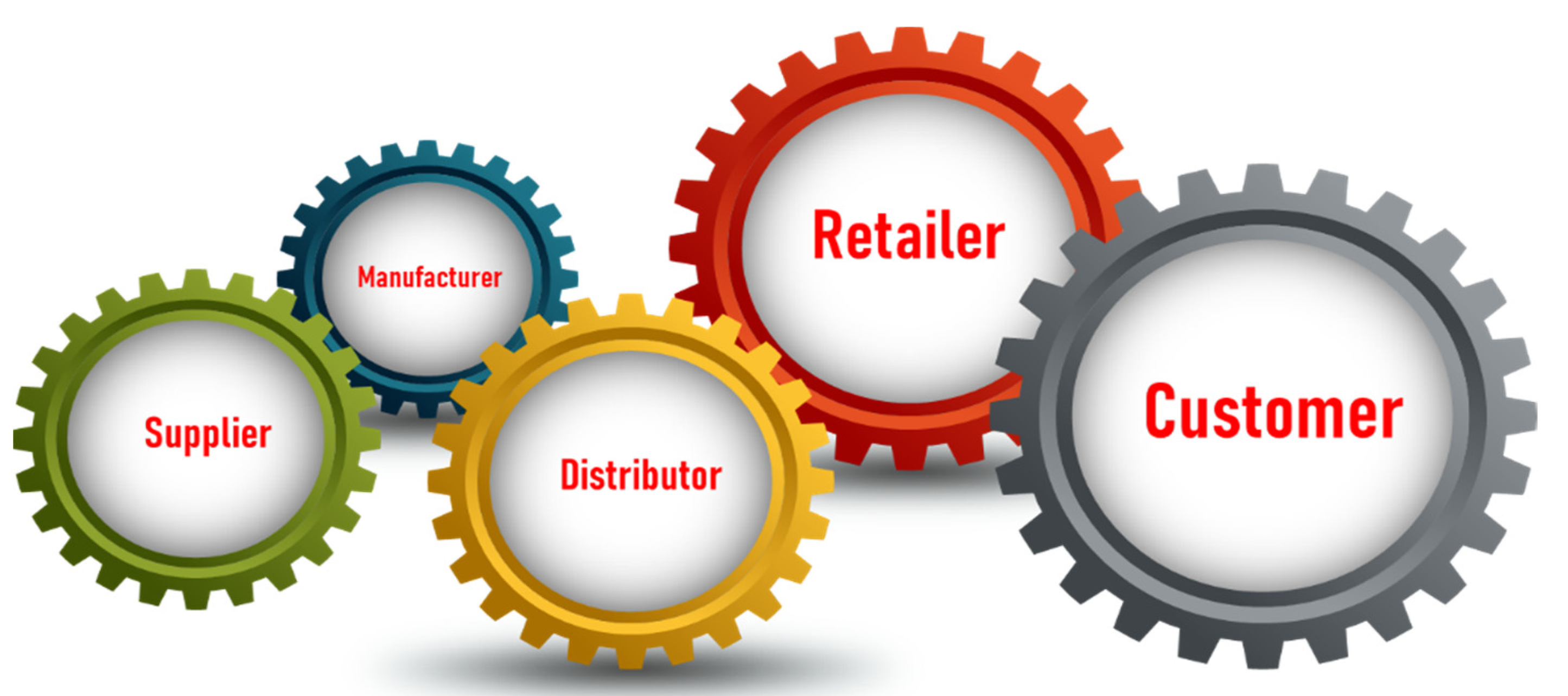
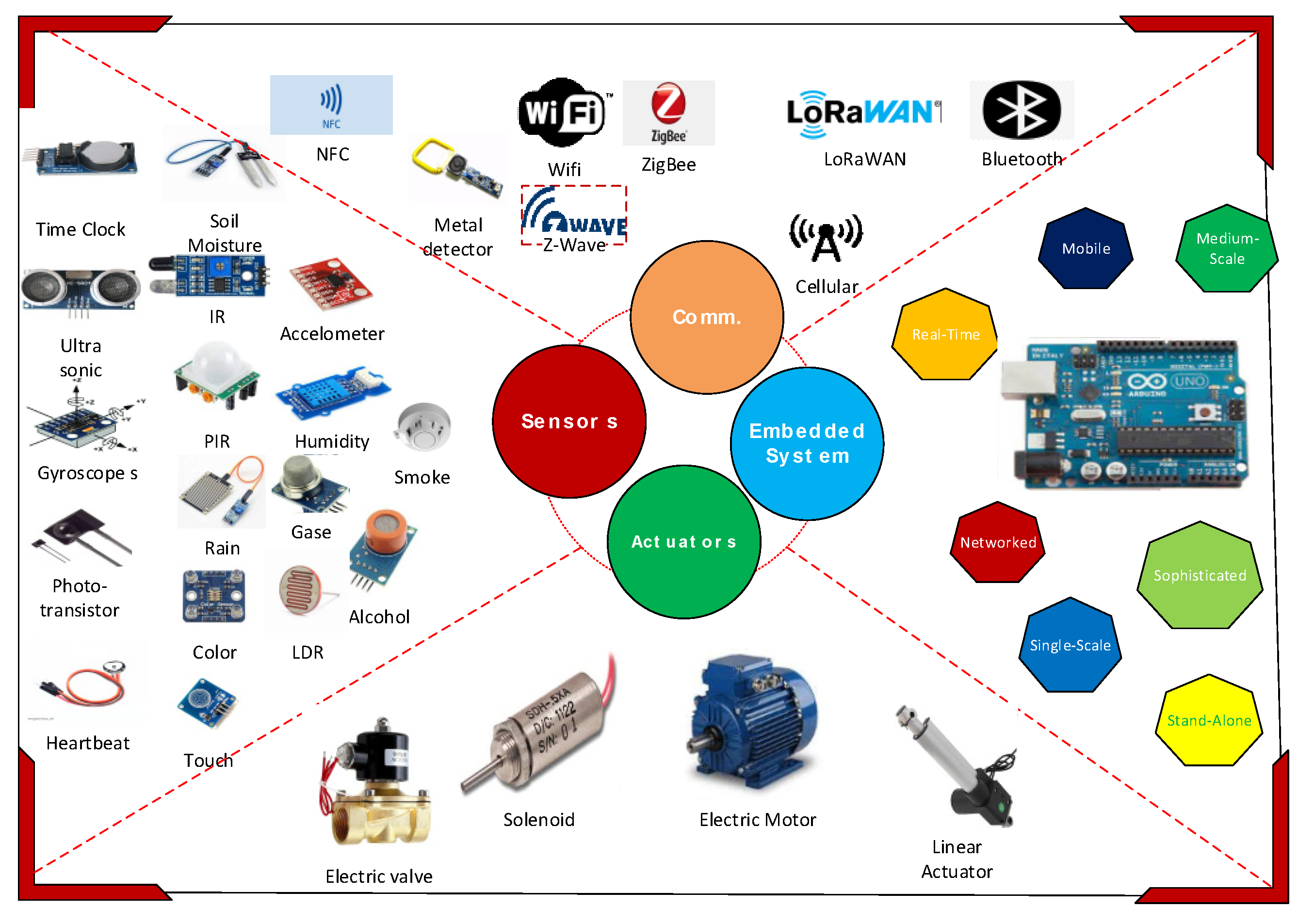
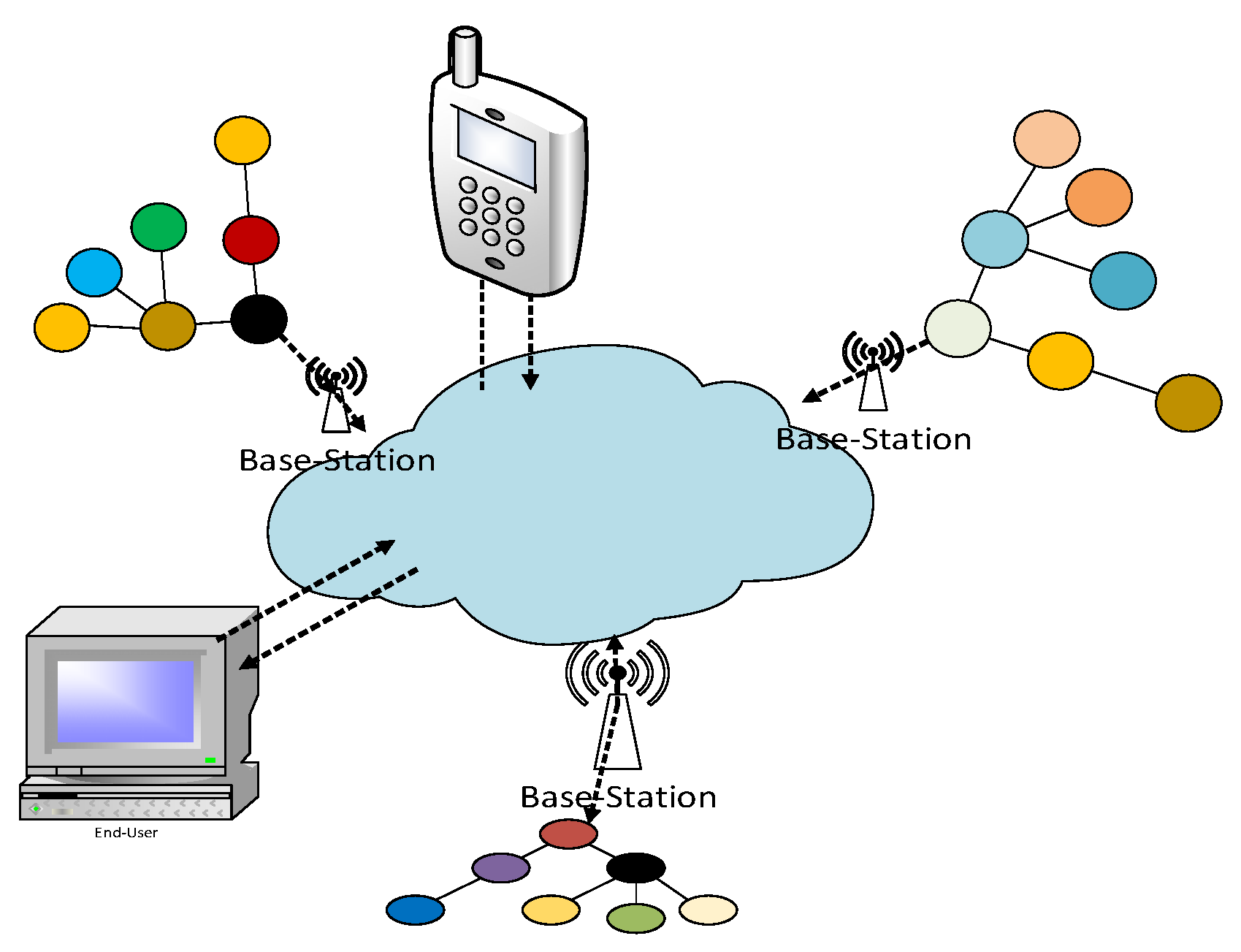
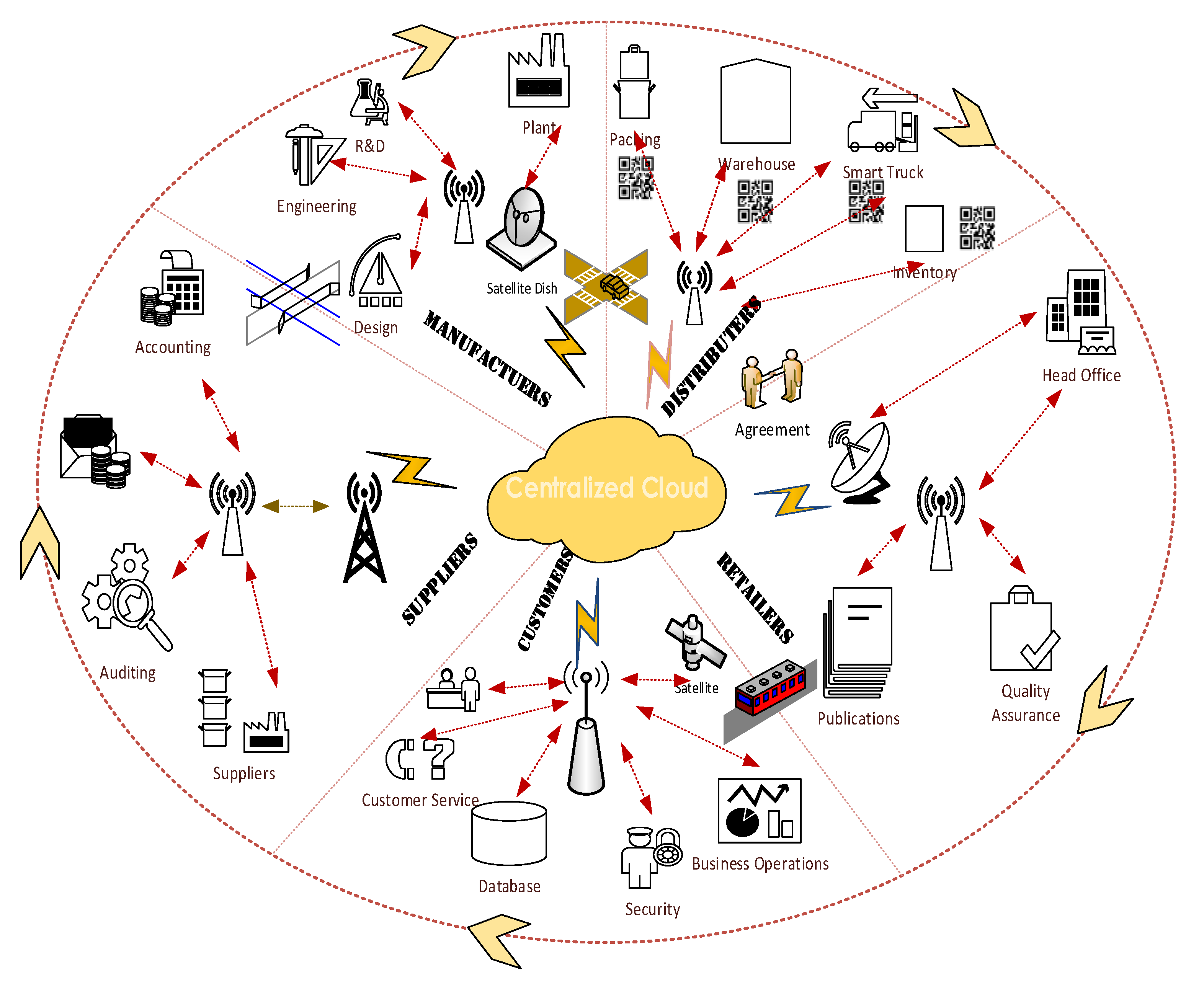
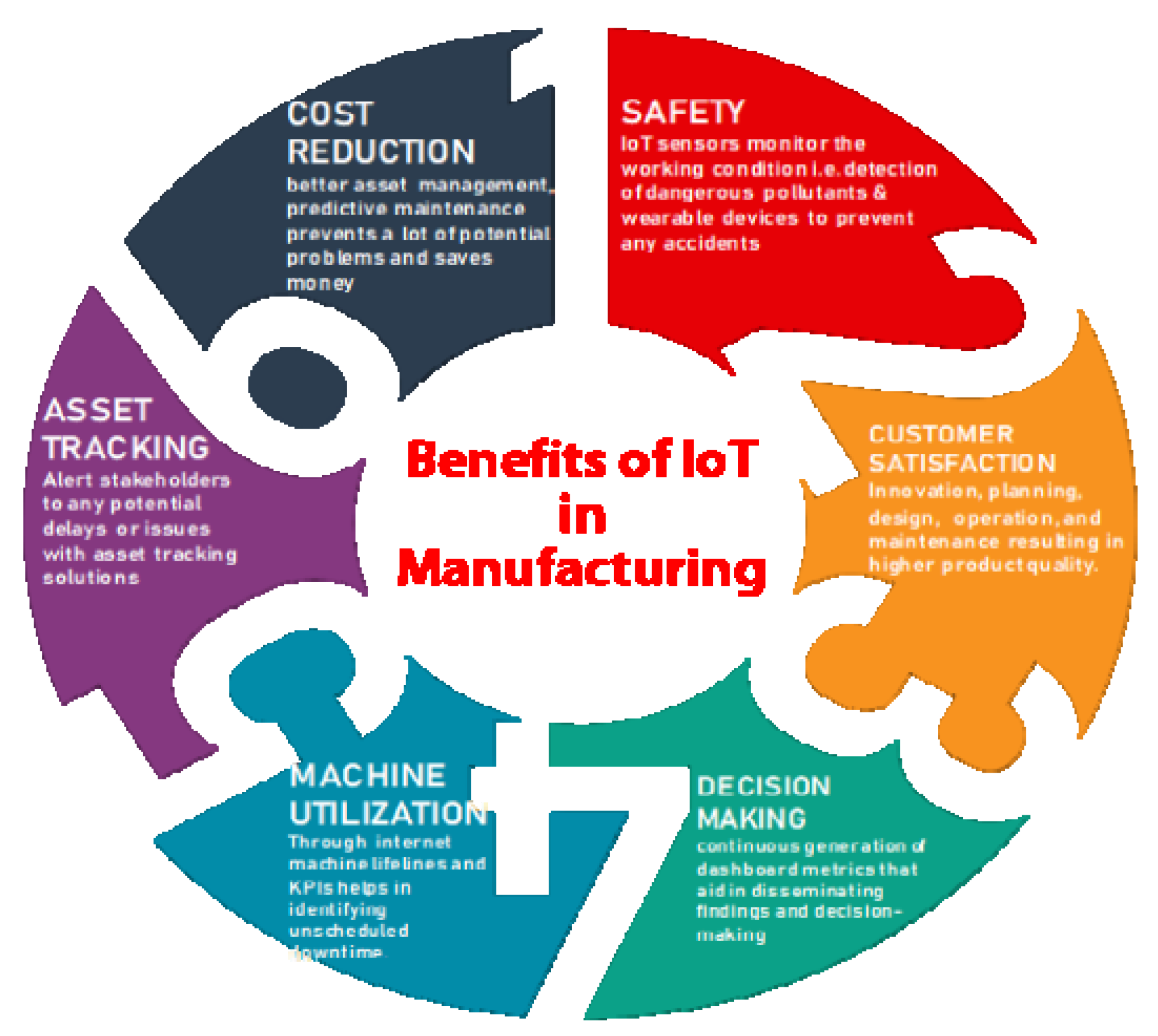
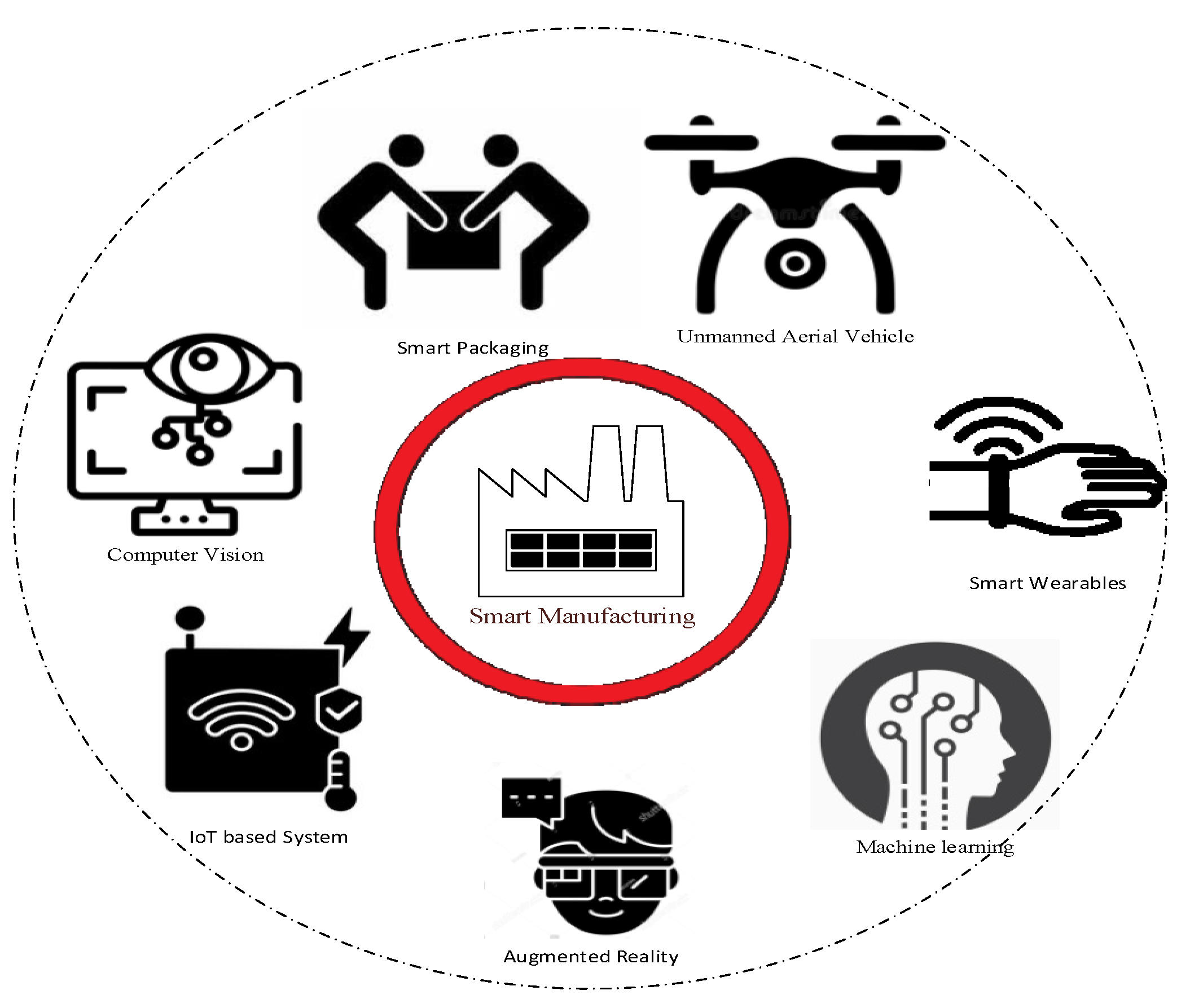
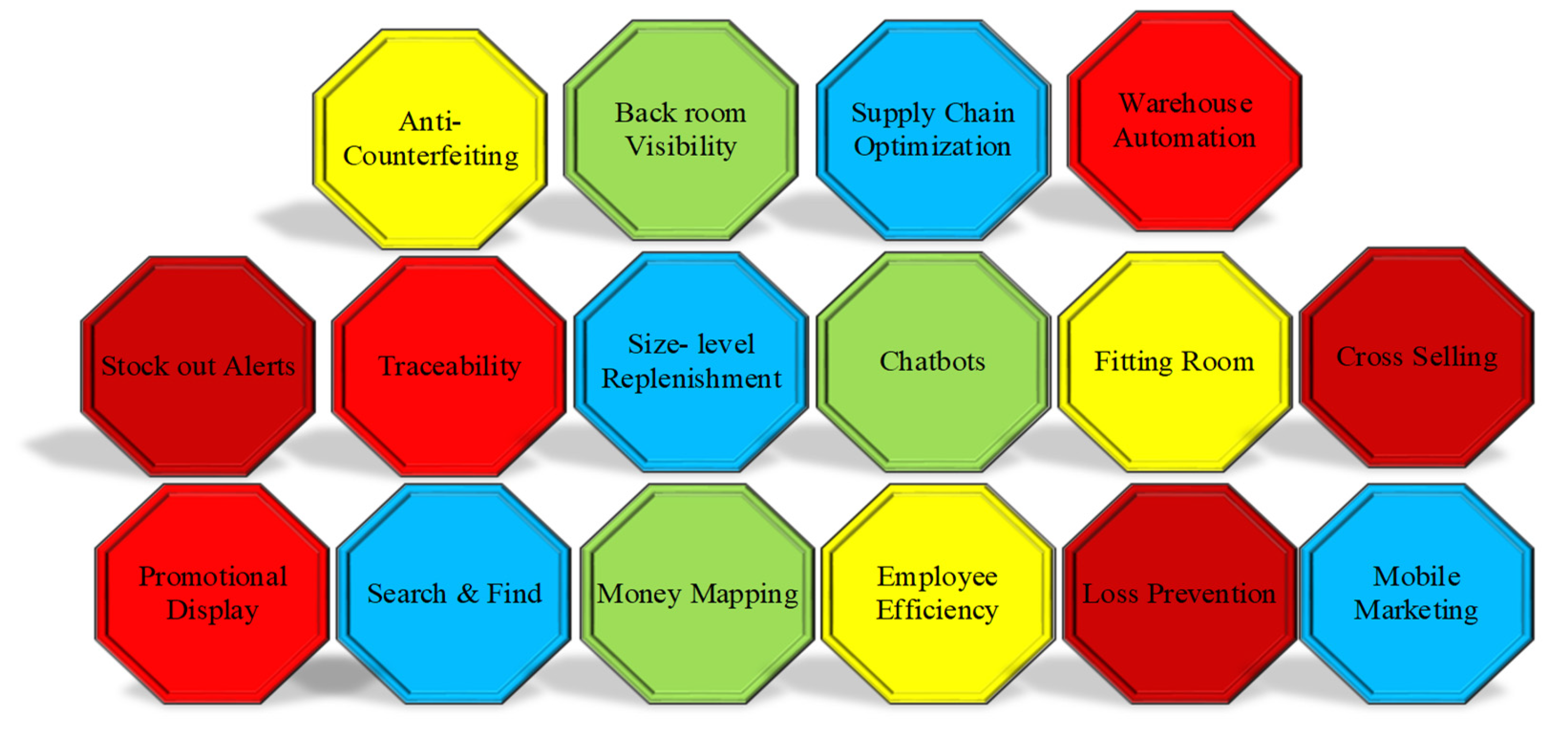
| Middleware | Features |
|---|---|
| Open Source | It provides data management services without any licenses, e.g., Thing-Speak and Kaa. |
| General Purpose | It can easily be connected with Arduino and Raspberry Pi, e.g., Temboo, Carriots. |
| Publicly Traded | It is developed and maintained by large corporations, e.g., IBM Watson, Microsoft Azure, AWS, Oracle. |
| End-to-End Connectivity | It is designed based on hardware, e.g., Particle cloud and Samsara [23]. |
Disclaimer/Publisher’s Note: The statements, opinions and data contained in all publications are solely those of the individual author(s) and contributor(s) and not of MDPI and/or the editor(s). MDPI and/or the editor(s) disclaim responsibility for any injury to people or property resulting from any ideas, methods, instructions or products referred to in the content. |
© 2022 by the authors. Licensee MDPI, Basel, Switzerland. This article is an open access article distributed under the terms and conditions of the Creative Commons Attribution (CC BY) license (https://creativecommons.org/licenses/by/4.0/).
Share and Cite
Khan, Y.; Su’ud, M.B.M.; Alam, M.M.; Ahmad, S.F.; Ahmad, A.Y.A.B.; Khan, N. Application of Internet of Things (IoT) in Sustainable Supply Chain Management. Sustainability 2023, 15, 694. https://doi.org/10.3390/su15010694
Khan Y, Su’ud MBM, Alam MM, Ahmad SF, Ahmad AYAB, Khan N. Application of Internet of Things (IoT) in Sustainable Supply Chain Management. Sustainability. 2023; 15(1):694. https://doi.org/10.3390/su15010694
Chicago/Turabian StyleKhan, Yasser, Mazliham Bin Mohd Su’ud, Muhammad Mansoor Alam, Syed Fayaz Ahmad, Ahmad Y. A. Bani Ahmad (Ayassrah), and Nasir Khan. 2023. "Application of Internet of Things (IoT) in Sustainable Supply Chain Management" Sustainability 15, no. 1: 694. https://doi.org/10.3390/su15010694
APA StyleKhan, Y., Su’ud, M. B. M., Alam, M. M., Ahmad, S. F., Ahmad, A. Y. A. B., & Khan, N. (2023). Application of Internet of Things (IoT) in Sustainable Supply Chain Management. Sustainability, 15(1), 694. https://doi.org/10.3390/su15010694






